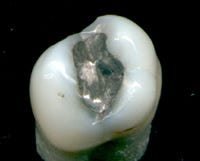As FDA continues its HHS-directed stall on deciding the safety of mercury-based dental amalgam, a new study shows that an assumed big reason for that decision (HHS isn’t saying) is not true. As it turns out, amalgam is not cheaper than its mercury-free alternative “composite” material when so-called “external” costs are factored in.
June 20, 2012
As FDA continues its directed delay by the United States Department of Health and Human Services (HHS) on deciding the safety of mercury-based dental amalgam, a new study shows that an assumed big reason for that decision (HHS isn’t saying) is not true. As it turns out, amalgam is not cheaper than its mercury-free alternative “composite” material when so-called “external” costs are factored in.
Entitled "The Real Cost of Dental Mercury," the study was prepared for a coalition of health, consumer and environmental groups by Brussels-based Concorde East/West, an international consulting firm that provides research to the United Nations and the U.S. Environmental Protection Agency, among others.
|
The use of mercury-based amalgam has long been a controversial. In 1840, Chapin A. Harris, the co-founder of the American Society of Dental Surgeons described it as "one of the most objectionable articles for filling teeth that can be employed." Image from Wikimedia Commons. |
The study report factors in the cost to society of keeping out of the environment dental amalgam mercury releases from crematoria and incinerators/wastewater sludges receiving effluent from dental offices, plus additional pollution control measures. These, it says, add up to an extra $41–67 per amalgam filling.
On top of that, the study found an additional “avoided cost” of $60-128 per filling in benefits “for people and the environment that would result from a phase-out of mercury use in dentistry. These would include,” the report says, “such benefits as reduced health costs, reduced environmental effects, additional jobs created, etc.”
In addition to the assumed lower cost of mercury-based amalgam (harm is minimal and questionable, helps the poor), other reasons for the HHS-directed stall on FDA’s decision - initially promised for the end of last year - include the political clout in an election year of the fiercely pro-amalgam American Dental Association, and the risk that an FDA reversal on the issue could open a legal can of worms for dentists.
There is a hefty paper trail stretching back more than 30 years that could be used in lawsuits against dentists for covering up, with FDA help, the cause of debilitating illnesses induced by unnecessary exposure to mercury in the mouth.
At HHS direction, FDA seems certain to keep the lid on this matter for the indefinite future. Neither Democrats nor Republicans want dentists to be hurt on this issue, and as HHS secretary Kathleen Sebelius demonstrated last December in her infamous Plan B “emergency contraceptive” directive to the agency, FDA is hostage in its scientific decisionmaking to the politics of the day.
About the Author(s)
You May Also Like



